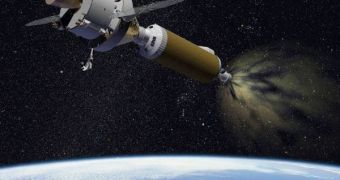Experts with Lockheed Martin have begun pitching a new mission called L2-Farside Mission, which revolves around using the NASA-ordered Orion Crew Exploration Vehicle, under development at the corporation.
The American space agency has officially canceled Project Constellation, and with it the chances it had of going back to the Moon. The Orion capsule was a part of the project, and it is the only component to survive the budget cuts, but just barely.
Under the new space plan proposed by NASA and US President Barack Obama, the spacecraft was to become nothing more than an escape vehicle for the International Space Station (ISS).
The orbital outpost currently relies exclusively on Russian-built Soyuz capsules to ensure that the permanent, six-astronaut crew can get to Earth safely in case of an emergency.
But Lockheed Martin believes that the space probe – which is being developed to accommodate a human crew – is capable of a lot more, hence the development of this mission proposal.
What the company is asking for is that astronauts be sent to the far side of the Moon inside an Orion space capsule, to the L2 Lagrangian point. There are five such points around Earth, Space reports.
The thing that makes them special from other orbital points is that they represent locations in which a spacecraft (for example) will always remain in the same relative position in regards to the Sun-Moon-Earth system.
In addition to the scientific benefits of such an endeavor, the trip could also help space agencies and their contractors to identify and troubleshoot various issues related to space travel.
If this is achieved, then the goal that NASA set for itself – of reaching a near-Earth object (NEO) by 2025 and Mars by the 2030s – could become a lot more feasible than it is today.
One of the primary goals of such a mission would be improving teleoperation capabilities, as in how to control robots on the lunar surface from orbit. This will be critical for exploring the Red Planet.
“We have come up with a sequence of missions that we've named 'Stepping Stones,' which begins with flights in low Earth orbit and incrementally builds towards a human mission to the moons of Mars in the 2030s,” explains Josh Hopkins.
The expert is based at the Lockheed Martin Human Spaceflight Advanced Programs department. He explains that the first Orion could carry out such a mission sometime between 2016 and 2018.
It remains to be seen whether anyone will take the corporation on its offer, but it would sure be interesting to see some practice before astronauts venture to meet up with a NEO, or head for Mars.

 14 DAY TRIAL //
14 DAY TRIAL //